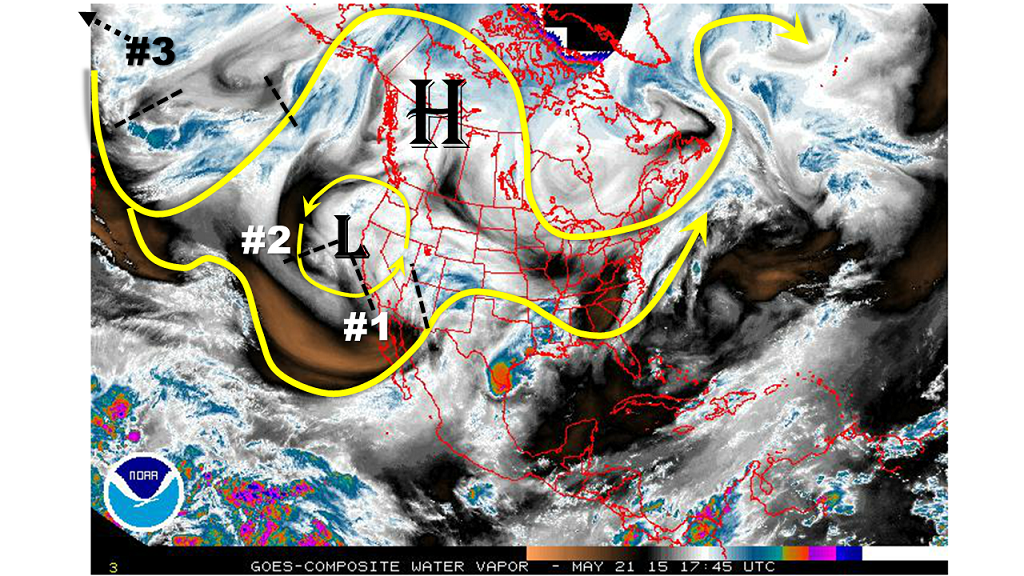Issue Date: 5/21/2015
Issue Time: 3:10 PM
The unprecedented wet May conditions continue over most of the state. East of the Divide, soils continue to stay saturated with May precipitation already running at up to 5-fold above average! The lack of sunshine has kept temperatures unseasonably cold with most locations running 4-6F below average. West of the Divide, late season snow and rains are doing wonders to help the drought situation. Most of Colorado may be drought free should the continuous rains keep falling over the next few weeks. And it appears they will.
The active feed of subtropical disturbances will continue. As shown by the water vapor image, below, a “split-flow” pattern continues to be active off the west coast of North America. In such a pattern, a blocking high sets up over Northwest Canada (or sometimes south of Alaska) and diverts the main jet stream well to the north. Meanwhile, a separate subtropical jet stream separates from the main jet stream and produces disturbances that frequently cause rainfall across the southwest U.S., including Colorado.
Over the next two weeks, we continue to foresee this pattern creating many disturbances that will move across our state. Overall, the pattern will be particularly busy through Memorial Day weekend (Events #1 and 2 on the water vapor image), followed by 3-5 days of overall quieter weather. However, even during the “quieter” weather period, there will likely be scattered thunderstorm activity especially over the higher terrain. We do not expect this activity to add up to much rainfall. Then, a re-invigoration of active weather (Event #3) will occur from a disturbance that is currently over the western Pacific Ocean.
The three events that we have identified are:
- Event #1: Friday (May 22)
- Light to moderate precipitation mainly east of the Continental Divide.
- Elevated flood threat for Northeast Plains due to saturated conditions.
- Event #2: Sunday through Memorial Day (May 24-25)
- Cut-off will approach Colorado causing moderate to heavy rainfall, mainly across the northern half of the state
- Elevated flood threat due to saturated conditions and large snowpack across the Continental Divide
- Event #3: Next Sunday through Tuesday (May 31-June 2)
- A large-scale disturbance with a familiar cut-off look will approach Colorado next weekend
- The combination of strong dynamics and potential subtropical moisture will cause an elevated flood threat for a 2-3 day period
Event #1: Friday (May 22)
An Elevated Flood Threat For The Northeast Plains
A disturbance will quickly move across the state on Friday, limiting the rainfall potential. However, strong to severe thunderstorms will be likely over the Northeast Plains. Large hail and strong winds will be possible, and stronger thunderstorms could cause very heavy rainfall leading to flash flooding over the already saturated soils.
Event #2: Sunday (May 24)
Elevated Flood Threat For Northern Mountains and Front Range Due To “Rain-on-Snow”
The cut-off low off the California coast will drift over Colorado on Sunday setting the stage for a widespread rainfall event. While most areas will not see more than 0.5 inch of rain, the Northern Mountains and Front Range foothills could see amounts over 1 inch. Due to the large snowpack currently in place, and elevated flood threat is issued for that region for minor stream flooding. Hikers and campers should monitor NWS watches and warnings for their particular region of interest.
Event #3: Friday (5-22-2015) through Sunday (5-24-2015)
An Elevated Flood Threat Will Likely Exist, But Exact Location Is Not Set In Stone
After a week of relatively quieter and warmer weather, it looks like Mother Nature will conspire to form another large-scale disturbance off the North American coast. While similar to past disturbances, this feature may have the extra “benefit” of having direct access to moisture from a potentially strong tropical disturbance south of the Baja of California. Such a setup has all the necessary features for a heavy rainfall threat across Colorado this time of year. Currently, the model guidance and our intuition suggests the largest threat in the Southeast Plains and Raton Ridge, but we will refine this area as the event draws nearer.


